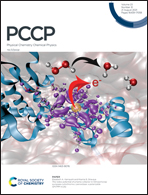Structural effects on the bromination rate and selectivity of alkylbenzenes and alkoxybenzenes in aqueous solution†
Abstract
Aqueous free bromine species (e.g., HOBr, BrCl, Br2, BrOCl, Br2O, and H2OBr+) can react with activated aromatic compounds via electrophilic aromatic substitution to generate products with industrial applications, environmental consequences, and potentially adverse biological effects. The relative contributions of these brominating agents to overall bromination rates can be calculated via nonlinear regression analyses of kinetic data collected under a variety of solution conditions, including variations in parameters (e.g., [Cl−], [Br−], and pH) known to influence free bromine speciation. Herein, kinetic experiments conducted in batch reactors were employed to evaluate the contributions of steric and electronic effects on bromination of monosubstituted alkylbenzenes (ethyl, isopropyl, tert-butyl) and alkoxybenzenes (ethoxy, isopropoxy, tert-butoxy) and to elucidate the inherent reactivities of aqueous brominating agents towards these aromatic compounds. For bromination at the para position of alkylbenzenes, overall reactivity increased from tert-butyl < ethyl ≈ isopropyl. For bromination at the para position of alkoxybenzenes, reactivity increased from tert-butoxy < ethoxy < isopropoxy. In going from ethyl to tert-butyl and ethoxy to isopropoxy, unfavorable steric effects attenuated the favorable electronic effects imparted by the substituents. When comparing unsubstituted benzene, alkyl-, and alkoxybenzenes, the structure of the substituent has a significant effect on bromination rates, nucleophile regioselectivity, and electrophile chemoselectivity. Hirshfeld charges were useful predictors of reactivity and regioselectivity. The experimental results were also modeled using Taft equations. Collectively, these findings indicate that steric effects, electronic effects, and brominating agents other than HOBr can influence aromatic compound bromination in solutions of free bromine.

- This article is part of the themed collection: 2021 PCCP HOT Articles


 Please wait while we load your content...
Please wait while we load your content...